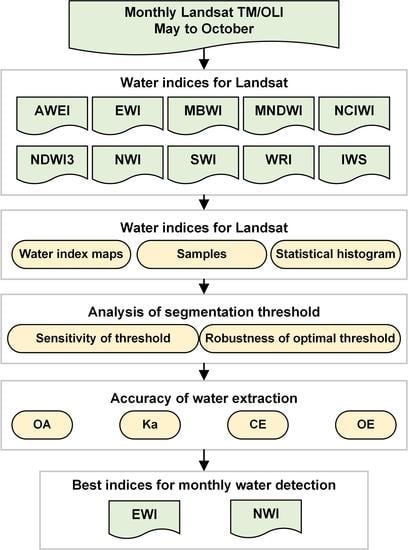Comparing Water Indices for Landsat Data for Automated Surface Water Body Extraction under Complex Ground Background: A Case Study in Jilin Province
Abstract
1. Introduction
1.1. Background
1.2. Related Works
1.2.1. Construction and Selection of Water Index
1.2.2. Determination of the Optimal Segmentation Threshold
1.2.3. Monthly Distribution of Surface Water
1.3. Contributions
2. Materials and Methods
2.1. Study Area
2.2. Materials
2.2.1. Landsat Multispectral Data and Preprocessing
2.2.2. Selection of Reference Samples
2.3. Methods
2.3.1. Calculating Multispectral Water Indices
2.3.2. Obtaining Optimal Segmentation Thresholds Using the OTSU Algorithm
2.3.3. Surface Water Mapping and Accuracy Analysis Method
3. Results
3.1. Visual Analysis of Inter-Class Separability
3.2. Analysis of Segmentation Threshold
3.2.1. Sensitivity of Segmentation Threshold
3.2.2. Robustness of the Optimal Threshold
3.3. The Accuracy of Water Extraction
4. Discussion
5. Conclusions
Author Contributions
Funding
Acknowledgments
Conflicts of Interest
Abbreviations
| 2D-OTSU | Two-dimensional OTSU |
| AWEI | Automated Water Extraction Index |
| AWEIsh | Automated Water Extraction Index for images with shadows |
| AWEInsh | Automated Water Extraction Index for images without shadows |
| CE | Commission error |
| DN | Digital number |
| EWI | Enhanced Water Index |
| FLAASH | Fast Line-of-sight Atmospheric Analysis of Hypercubes |
| IWS | Index of Water Surfaces |
| Ka | Kappa coefficient |
| MBWI | Multi-Band Water Index |
| MNDWI | Modified Normalized Difference Water Index |
| MODIS | Moderate-resolution Imaging Spectroradiometer |
| NCIWI | New Comprehensive Water Index |
| NDWI3 | Modified Normalized Difference Water Index |
| NIR | Near-infrared |
| NWI | New Water Index |
| OA | Overall accuracy |
| OE | Omission error |
| OLI | Operational Land Imager |
| SAR | Synthetic aperture radar |
| SWI | Sentinel-2 Water Index |
| SWIR | Short-wave infrared |
| TM | Landsat Thematic Mapper |
| TOA | Top of atmosphere |
| WI2015 | Water Index built in 2015 |
| WRI | Water Ratio Index |
| WOTSU | Weighted one-dimensional OTSU |
References
- Palmer, S.C.J.; Kutser, T.; Hunter, P.D. Remote sensing of inland waters: Challenges, progress and future directions. Remote Sens. Environ. 2015, 157, 1–8. [Google Scholar] [CrossRef]
- Li, J.; Ma, R.; Cao, Z.; Xue, K.; Xiong, J.; Hu, M.; Feng, X. Satellite Detection of Surface Water Extent: A Review of Methodology. Water 2022, 14, 1148. [Google Scholar] [CrossRef]
- Khalid, H.W.; Khalil, R.M.Z.; Qureshi, M.A. Evaluating spectral indices for water bodies extraction in western Tibetan Plateau. Egypt. J. Remote Sens. Space Sci. 2021, 24, 619–634. [Google Scholar] [CrossRef]
- Quang, D.N.; Linh, N.K.; Tam, H.S.; Viet, N.T. Remote sensing applications for reservoir water level monitoring, sustainable water surface management, and environmental risks in Quang Nam province, Vietnam. J. Water Clim. Chang. 2021, 12, 3045–3063. [Google Scholar] [CrossRef]
- Li, A.; Fan, M.; Qin, G.; Xu, Y.; Wang, H. Comparative Analysis of Machine Learning Algorithms in Automatic Identification and Extraction of Water Boundaries. Appl. Sci. 2021, 11, 10062. [Google Scholar] [CrossRef]
- Loudière, D.; Gourbesville, P. Rapport mondial des Nations Unies sur la mise en valeur des ressources en eau 2020. La Houille Blanche 2020, 106, 76–81. [Google Scholar] [CrossRef]
- Wang, G.; Wu, M.; Wei, X.; Song, H. Water Identification from High-Resolution Remote Sensing Images Based on Multidimensional Densely Connected Convolutional Neural Networks. Remote Sens. 2020, 12, 795. [Google Scholar] [CrossRef]
- Yang, X.; Qin, Q.; Yésou, H.; Ledauphin, T.; Koehl, M.; Grussenmeyer, P.; Zhu, Z. Monthly estimation of the surface water extent in France at a 10-m resolution using Sentinel-2 data. Remote Sens. Environ. 2020, 244, 111803. [Google Scholar] [CrossRef]
- Herndon, K.; Muench, R.; Cherrington, E.; Griffin, R. An Assessment of Surface Water Detection Methods for Water Resource Management in the Nigerien Sahel. Sensors 2020, 20, 431. [Google Scholar] [CrossRef]
- Li, M.; Hong, L.; Guo, J.; Zhu, A. Automated Extraction of Lake Water Bodies in Complex Geographical Environments by Fusing Sentinel-1/2 Data. Water 2021, 14, 30. [Google Scholar] [CrossRef]
- Kseňak, Ľ.; Pukanská, K.; Bartoš, K.; Blišťan, P. Assessment of the Usability of SAR and Optical Satellite Data for Monitoring Spatio-Temporal Changes in Surface Water: Bodrog River Case Study. Water 2022, 14, 299. [Google Scholar] [CrossRef]
- Guo, Z.; Wu, L.; Huang, Y.; Guo, Z.; Zhao, J.; Li, N. Water-Body Segmentation for SAR Images: Past, Current, and Future. Remote Sens. 2022, 14, 1752. [Google Scholar] [CrossRef]
- Xiong, L.; Deng, R.; Li, J.; Liu, X.; Qin, Y.; Liang, Y.; Liu, Y. Subpixel Surface Water Extraction (SSWE) Using Landsat 8 OLI Data. Water 2018, 10, 653. [Google Scholar] [CrossRef]
- Li, L.; Su, H.; Du, Q.; Wu, T. A novel surface water index using local background information for long term and large-scale Landsat images. ISPRS J. Photogramm. Remote Sens. 2021, 172, 59–78. [Google Scholar] [CrossRef]
- McFeeters, S.K. The use of the Normalized Difference Water Index (NDWI) in the delineation of open water features. Int. J. Remote Sens. 1996, 17, 1425–1432. [Google Scholar] [CrossRef]
- Xu, H. Modification of normalised difference water index (NDWI) to enhance open water features in remotely sensed imagery. Int. J. Remote Sens. 2006, 27, 3025–3033. [Google Scholar] [CrossRef]
- Yan, P.; Zhang, Y. A Study on Information Extraction of Water System in Semi-arid Regions with the Enhanced Water Index (EWI) and GIS Based Noise Remove Techniques. Remote Sens. Inf. 2007, 6, 62–67. [Google Scholar]
- Ding, F. A New Method for Fast Information Extraction of Water Bodies Using Remotely Sensed Data. Remote Sens. Technol. Appl. 2009, 24, 167–171. [Google Scholar]
- Fisher, A.; Flood, N.; Danaher, T. Comparing Landsat water index methods for automated water classification in eastern Australia. Remote Sens. Environ. 2016, 175, 167–182. [Google Scholar] [CrossRef]
- Hassani, M.; Chabou, M.C.; Hamoudi, M.; Guettouche, M.S. Index of extraction of water surfaces from Landsat 7 ETM+ images. Arab. J. Geosci. 2015, 8, 3381–3389. [Google Scholar] [CrossRef]
- Shen, L.; Li, C. Water body extraction from Landsat ETM+ imagery using adaboost algorithm. In Proceedings of the 2010 18th International Conference on Geoinformatics, Beijing, China, 18–20 June 2010; pp. 1–4. [Google Scholar]
- Wang, X.; Xie, S.; Zhang, X.; Chen, C.; Guo, H.; Du, J.; Duan, Z. A robust Multi-Band Water Index (MBWI) for automated extraction of surface water from Landsat 8 OLI imagery. Int. J. Appl. Earth Obs. Geoinf. 2018, 68, 73–91. [Google Scholar] [CrossRef]
- Feyisa, G.L.; Meilby, H.; Fensholt, R.; Proud, S.R. Automated Water Extraction Index: A new technique for surface water mapping using Landsat imagery. Remote Sens. Environ. 2014, 140, 23–35. [Google Scholar] [CrossRef]
- Xie, C.; Huang, X.; Zeng, W.; Fang, X. A novel water index for urban high-resolution eight-band WorldView-2 imagery. Int. J. Digit. Earth 2016, 9, 925–941. [Google Scholar] [CrossRef]
- Wen, Z.; Zhang, C.; Shao, G.; Wu, S.; Atkinson, P.M. Ensembles of multiple spectral water indices for improving surface water classification. Int. J. Appl. Earth Obs. Geoinf. 2021, 96, 102278. [Google Scholar] [CrossRef]
- Sanchez, G.C.; Dalmau, O.; Alarcon, T.E.; Sierra, B.; Hernandez, C. Selection and Fusion of Spectral Indices to Improve Water Body Discrimination. IEEE Access 2018, 6, 72952–72961. [Google Scholar] [CrossRef]
- Ferriby, H.; Nejadhashemi, A.P.; Hernandez-Suarez, J.S.; Moore, N.; Kpodo, J.; Kropp, I.; Eeswaran, R.; Belton, B.; Haque, M.M. Harnessing Machine Learning Techniques for Mapping Aquaculture Waterbodies in Bangladesh. Remote Sens. 2021, 13, 4890. [Google Scholar] [CrossRef]
- Yu, Z.; Di, L.; Rahman, M.S.; Tang, J. Fishpond Mapping by Spectral and Spatial-Based Filtering on Google Earth Engine: A Case Study in Singra Upazila of Bangladesh. Remote Sens. 2020, 12, 2692. [Google Scholar] [CrossRef]
- Rokni, K.; Ahmad, A.; Selamat, A.; Hazini, S. Water Feature Extraction and Change Detection Using Multitemporal Landsat Imagery. Remote Sens. 2014, 6, 4173–4189. [Google Scholar] [CrossRef]
- Mondejar, J.P.; Tongco, A.F. Near infrared band of Landsat 8 as water index: A case study around Cordova and Lapu-Lapu City, Cebu, Philippines. Sustain. Environ. Res. 2019, 29, 16. [Google Scholar] [CrossRef]
- Jiang, W.; Ni, Y.; Pang, Z.; Li, X.; Ju, H.; He, G.; Lv, J.; Yang, K.; Fu, J.; Qin, X. An Effective Water Body Extraction Method with New Water Index for Sentinel-2 Imagery. Water 2021, 13, 1647. [Google Scholar] [CrossRef]
- Zhou, C.; Tian, L.; Zhao, H.; Zhao, K. A method of Two-Dimensional Otsu image threshold segmentation based on improved Firefly Algorithm. In Proceedings of the 2015 IEEE International Conference on Cyber Technology in Automation, Control, and Intelligent Systems (CYBER), Shenyang, China, 8–12 June 2015; pp. 1420–1424. [Google Scholar]
- Yin, D.; Cao, X.; Chen, X.; Shao, Y.; Chen, J. Comparison of automatic thresholding methods for snow-cover mapping using Landsat TM imagery. Int. J. Remote Sens. 2013, 34, 6529–6538. [Google Scholar] [CrossRef]
- Sheng, Y.; Song, C.; Wang, J.; Lyons, E.A.; Knox, B.R.; Cox, J.S.; Gao, F. Representative lake water extent mapping at continental scales using multi-temporal Landsat-8 imagery. Remote Sens. Environ. 2016, 185, 129–141. [Google Scholar] [CrossRef]
- Weekley, D.; Li, X. Tracking Multidecadal Lake Water Dynamics with Landsat Imagery and Topography/Bathymetry. Water Resour. Res. 2019, 55, 8350–8367. [Google Scholar] [CrossRef]
- Wang, P.; Li, Z.; Xu, C.; Wang, P. Region-wide glacier area and mass budgets for the Shaksgam River Basin, Karakoram Mountains, during 2000–2016. J. Arid. Land 2021, 13, 175–188. [Google Scholar] [CrossRef]
- Chen, Y.; Fan, R.; Yang, X.; Wang, J.; Latif, A. Extraction of Urban Water Bodies from High-Resolution Remote-Sensing Imagery Using Deep Learning. Water 2018, 10, 585. [Google Scholar] [CrossRef]
- Zhang, Y.J.; Liu, X.Y.; Zhang, Y.; Ling, X.; Huang, X. Automatic and Unsupervised Water Body Extraction Based on Spectral-Spatial Features Using GF-1 Satellite Imagery. Ieee Geosci. Remote Sens. Lett. 2019, 16, 927–931. [Google Scholar] [CrossRef]
- Pekel, J.-F.; Cottam, A.; Gorelick, N.; Belward, A.S. High-resolution mapping of global surface water and its long-term changes. Nature 2016, 540, 418–422. [Google Scholar] [CrossRef] [PubMed]
- Campos, J.C.; Sillero, N.; Brito, J.C. Normalized difference water indexes have dissimilar performances in detecting seasonal and permanent water in the Sahara–Sahel transition zone. J. Hydrol. 2012, 464–465, 438–446. [Google Scholar] [CrossRef]
- Liu, X.; Chen, L.; Zhang, G.; Zhang, J.; Wu, Y.; Ju, H. Spatiotemporal dynamics of succession and growth limitation of phytoplankton for nutrients and light in a large shallow lake. Water Res. 2021, 194, 116910. [Google Scholar] [CrossRef]
- Zhu, X.; Yuan, Y.; Wei, X.; Wang, L.; Wang, C. Dissimilatory iron reduction and potential methane production in Chagan Lake wetland soils with carbon addition. Wetl. Ecol. Manag. 2021, 29, 369–379. [Google Scholar] [CrossRef]
- Yang, Y.N.; Sheng, Q.; Zhang, L.; Kang, H.Q.; Liu, Y. Desalination of saline farmland drainage water through wetland plants. Agric. Water Manag. 2015, 156, 19–29. [Google Scholar] [CrossRef]
- You, Q. Determining paddy field spatiotemporal distribution and temperature influence using remote sensing in Songnen Plain, Northeastern China. Arab. J. Geosci. 2020, 13, 1075. [Google Scholar] [CrossRef]
- Zou, C.; Yang, X.Z.; Dong, Z.Y.; Wang, D. A Fast Water Information Extraction Method Based on GF-2 Remote Sensing Image. J. Graph. 2019, 40, 99. [Google Scholar]
- Ouma, Y.O.; Tateishi, R. A water index for rapid mapping of shoreline changes of five East African Rift Valley lakes: An empirical analysis using Landsat TM and ETM+ data. Int. J. Remote Sens. 2006, 27, 3153–3181. [Google Scholar] [CrossRef]
- Otsu, N. A Threshold Selection Method from Gray-Level Histograms. IEEE Trans. Syst. Man Cybern. 1979, 9, 62–66. [Google Scholar] [CrossRef]
- Xiao, L.; Ouyang, H.; Fan, C. An improved Otsu method for threshold segmentation based on set mapping and trapezoid region intercept histogram. Optik 2019, 196, 163106. [Google Scholar] [CrossRef]
- Huang, Y.; Xiong, L.; Liu, Y.; Deng, P.; Dan, B. Image segmentation of argon blowing based on improved Otsu algorithm. In Proceedings of the 2021 4th International Conference on Intelligent Autonomous Systems (ICoIAS), Wuhan, China, 14–16 May 2021; pp. 49–54. [Google Scholar]
- Yuan, X.-C.; Wu, L.-S.; Peng, Q. An improved Otsu method using the weighted object variance for defect detection. Appl. Surf. Sci. 2015, 349, 472–484. [Google Scholar] [CrossRef]
- Yan, D.; Huang, C.; Ma, N.; Zhang, Y. Improved Landsat-Based Water and Snow Indices for Extracting Lake and Snow Cover/Glacier in the Tibetan Plateau. Water 2020, 12, 1339. [Google Scholar] [CrossRef]
- He, Z.; Sun, L.; Huang, W.; Chen, L. Thresholding segmentation algorithm based on Otsu criterion and line intercept histogram. Opt. Precis. Eng. 2012, 20, 2315–2323. [Google Scholar] [CrossRef]
- Asfaw, W.; Haile, A.T.; Rientjes, T. Combining multisource satellite data to estimate storage variation of a lake in the Rift Valley Basin, Ethiopia. Int. J. Appl. Earth Obs. Geoinf. 2020, 89, 102095. [Google Scholar] [CrossRef]
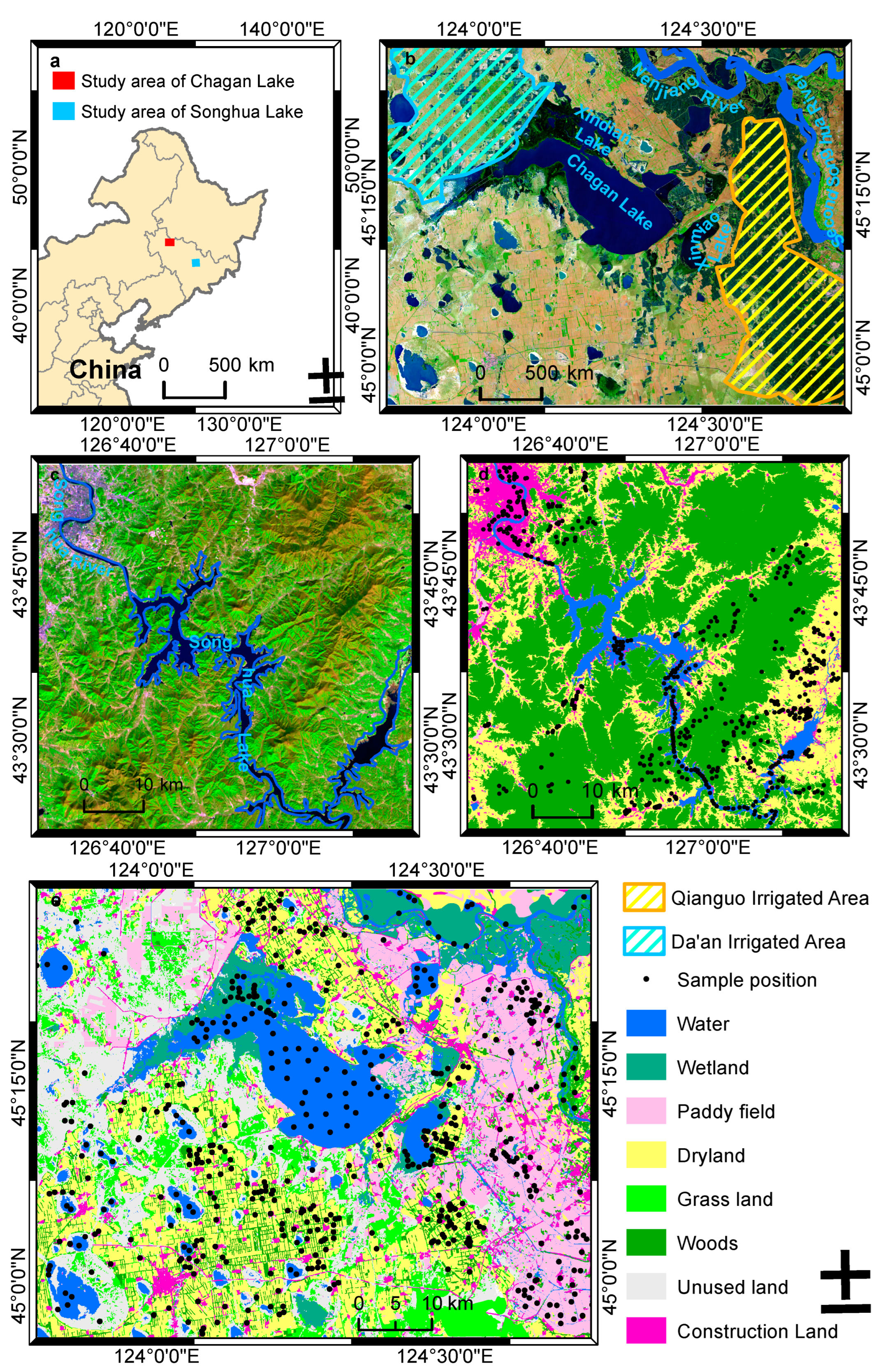
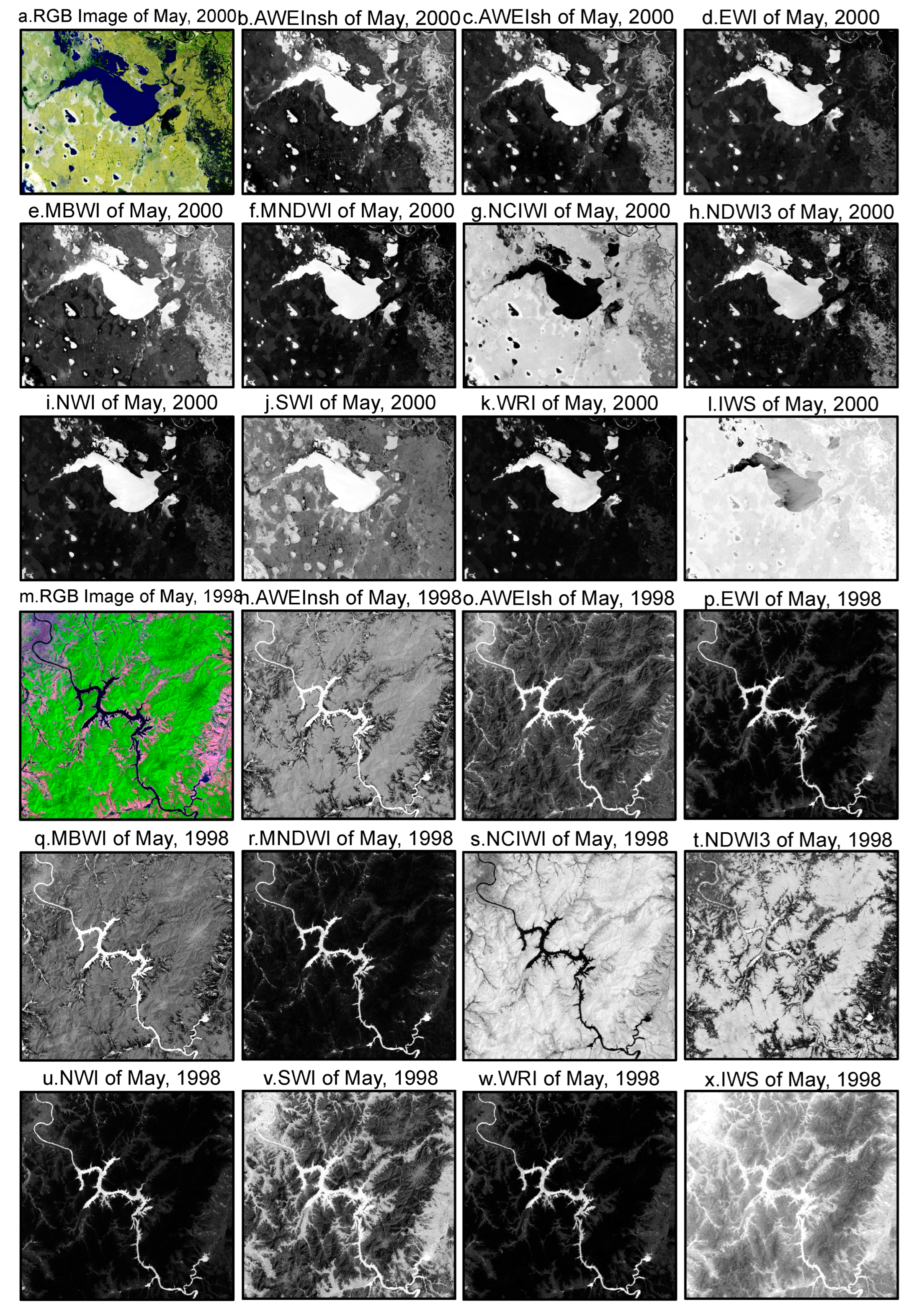

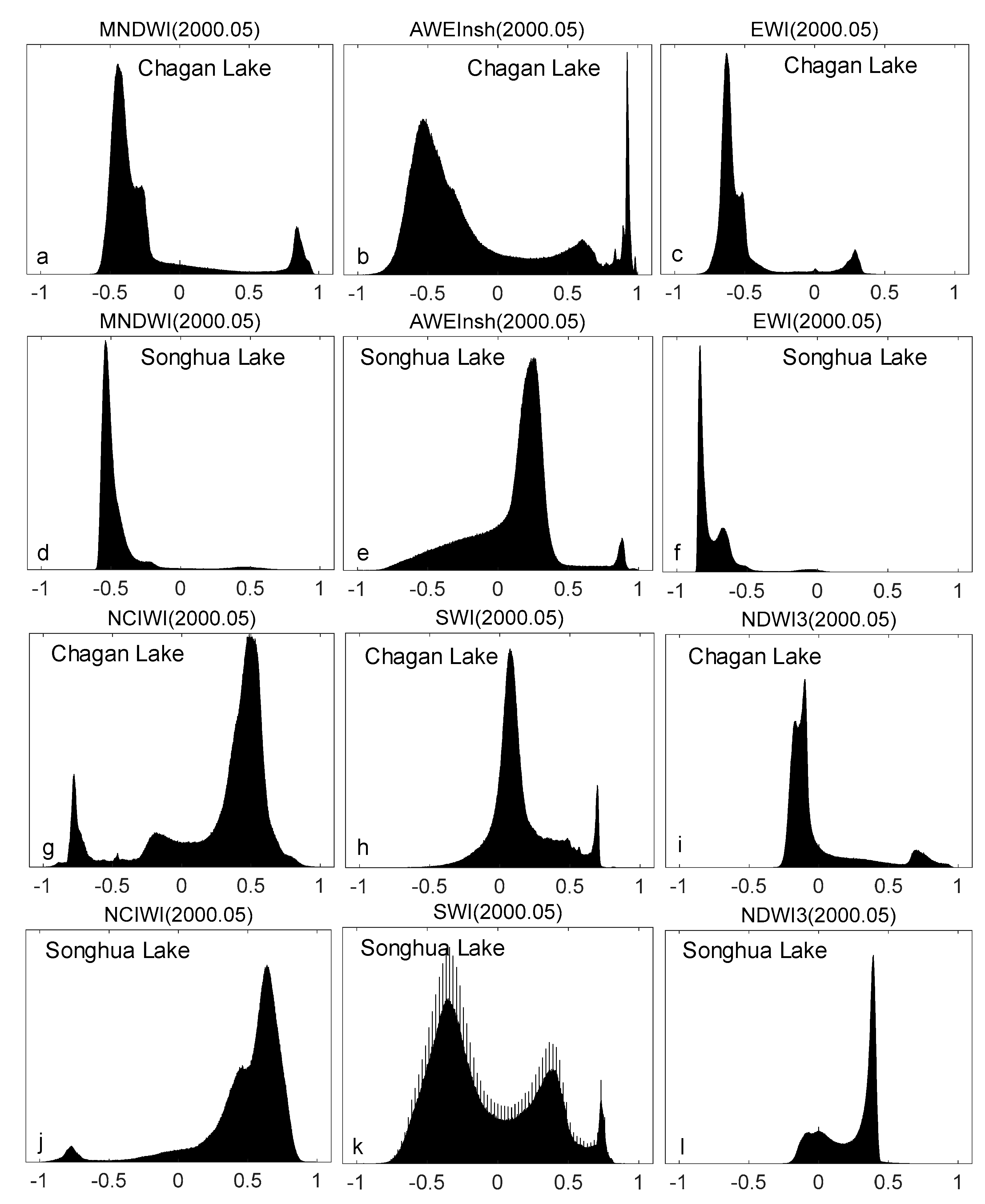
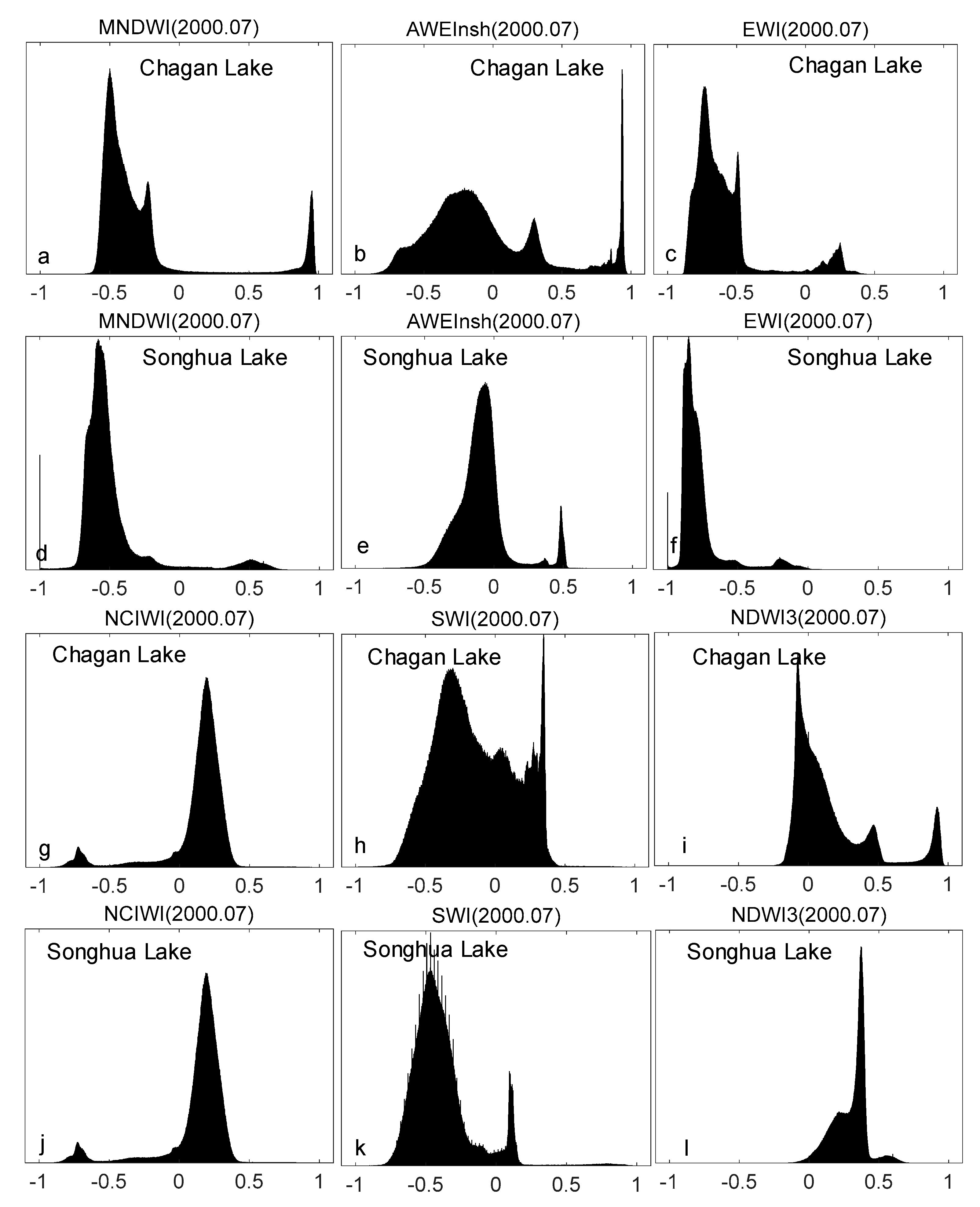
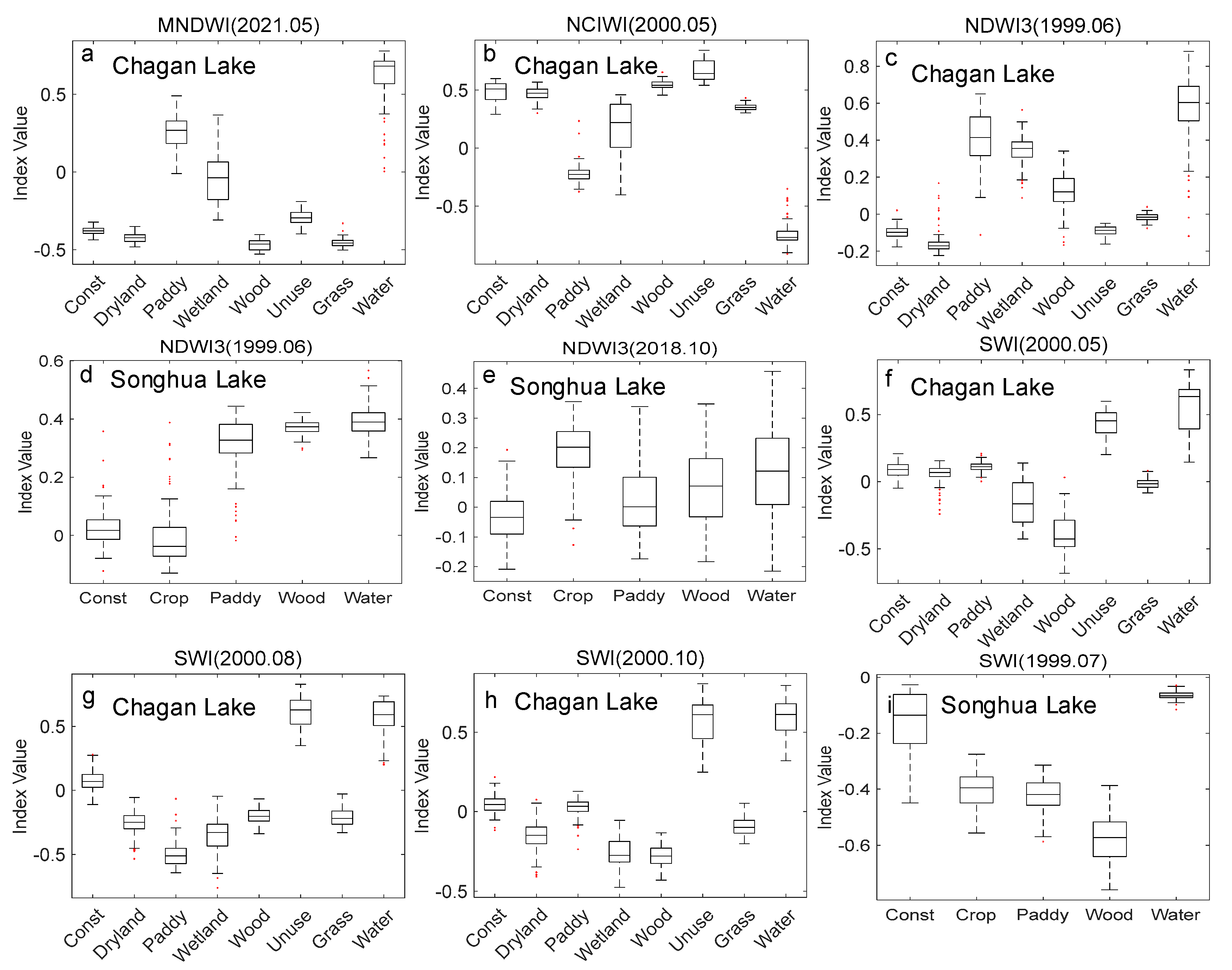
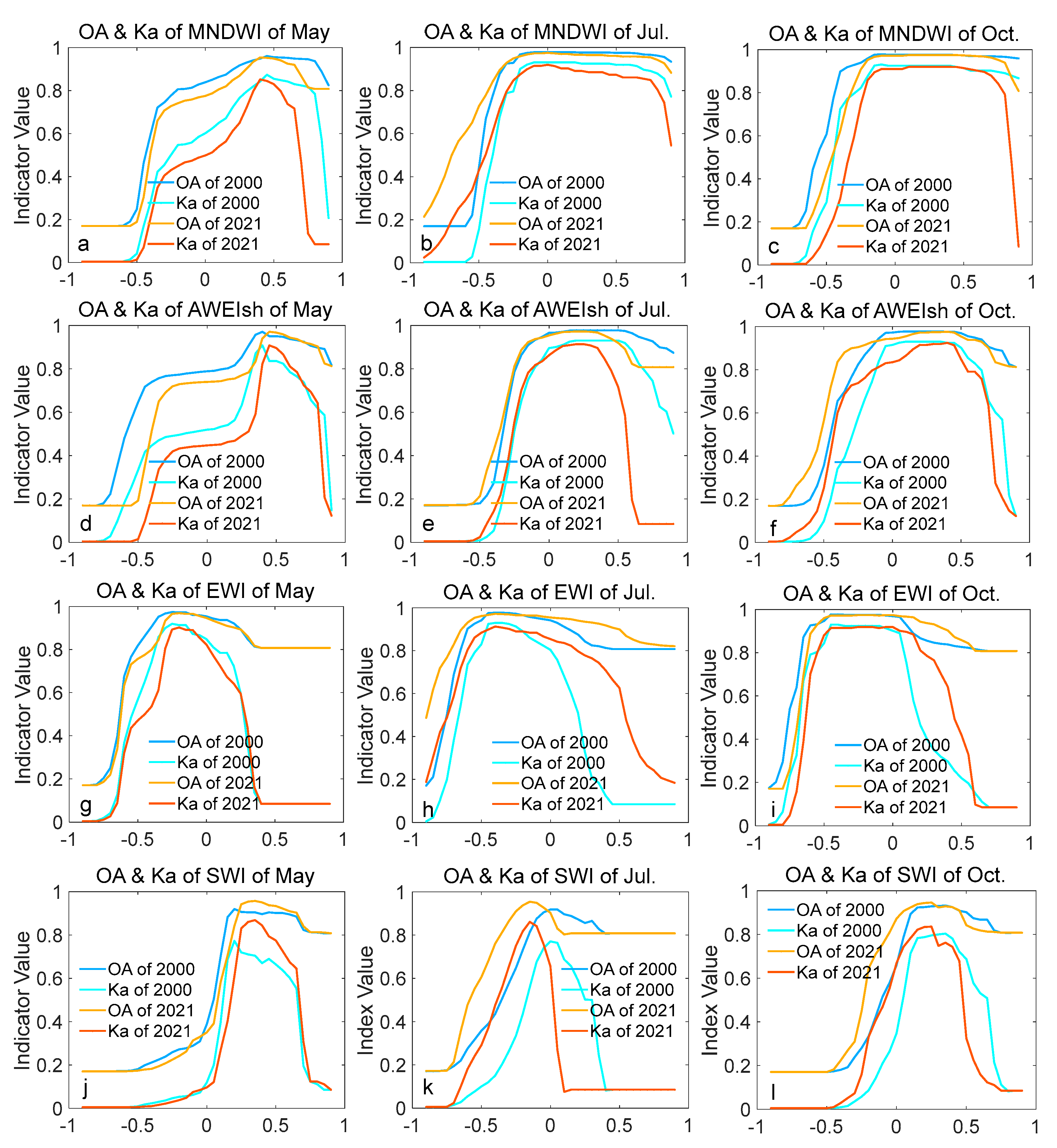
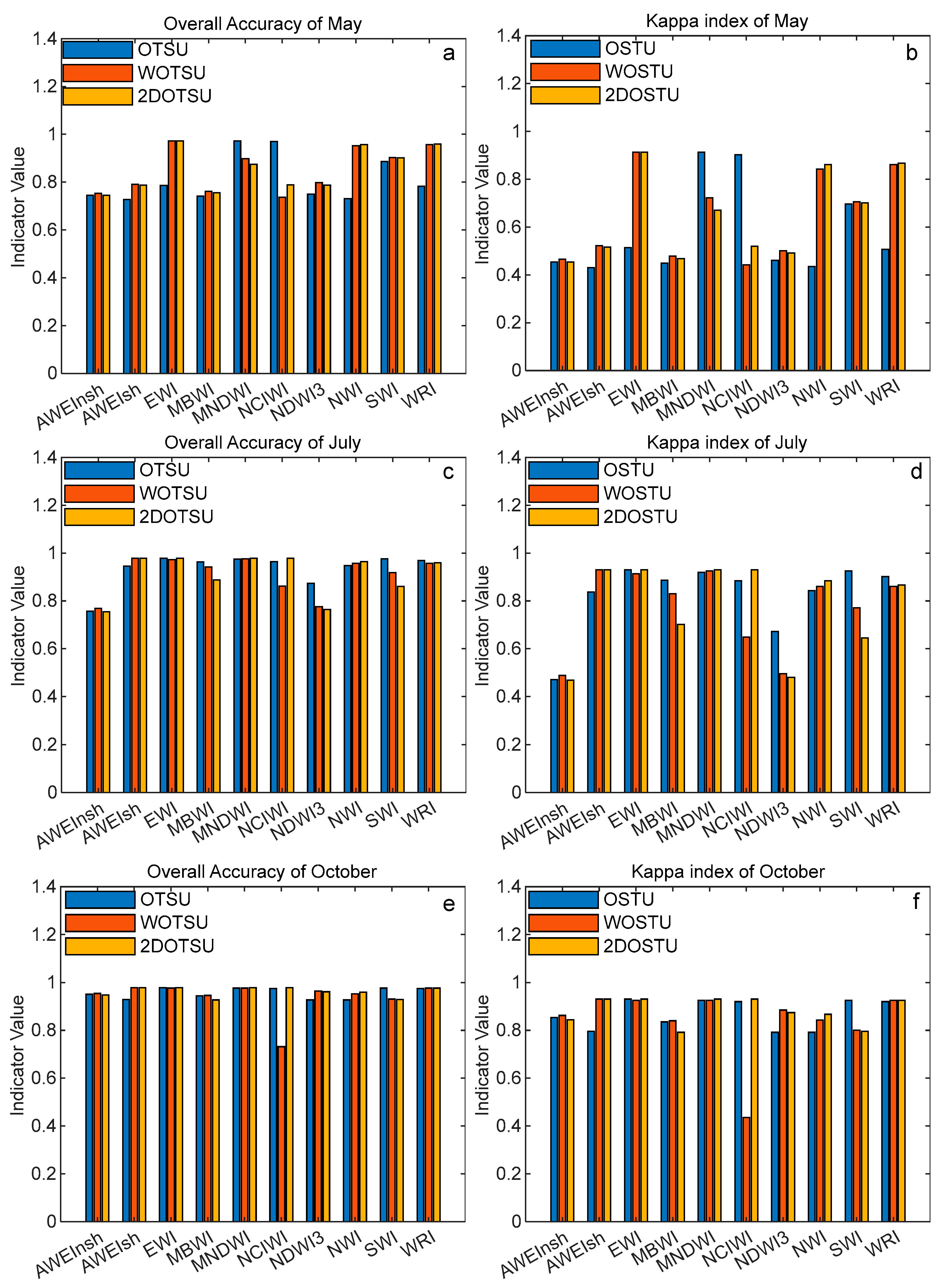
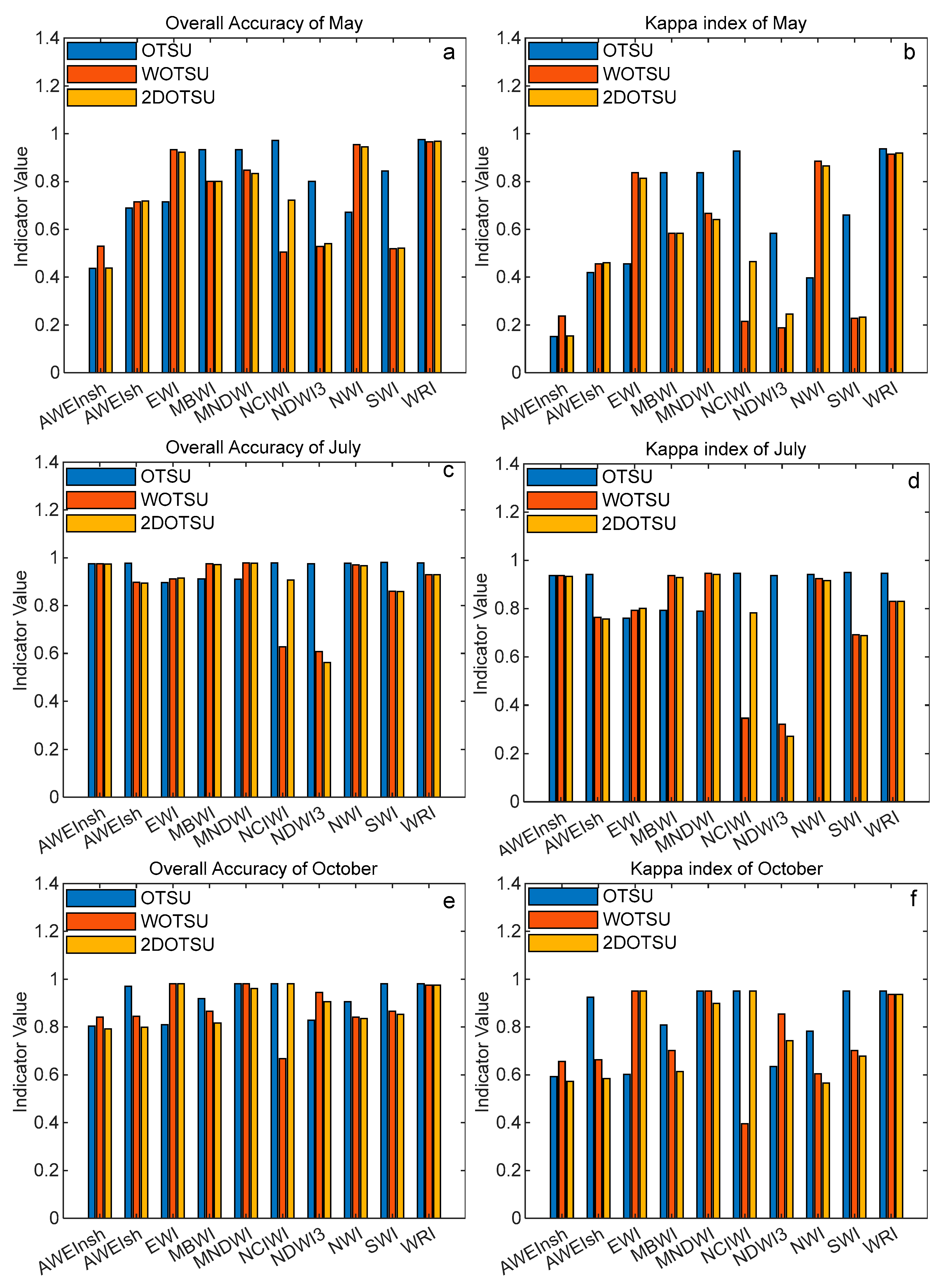


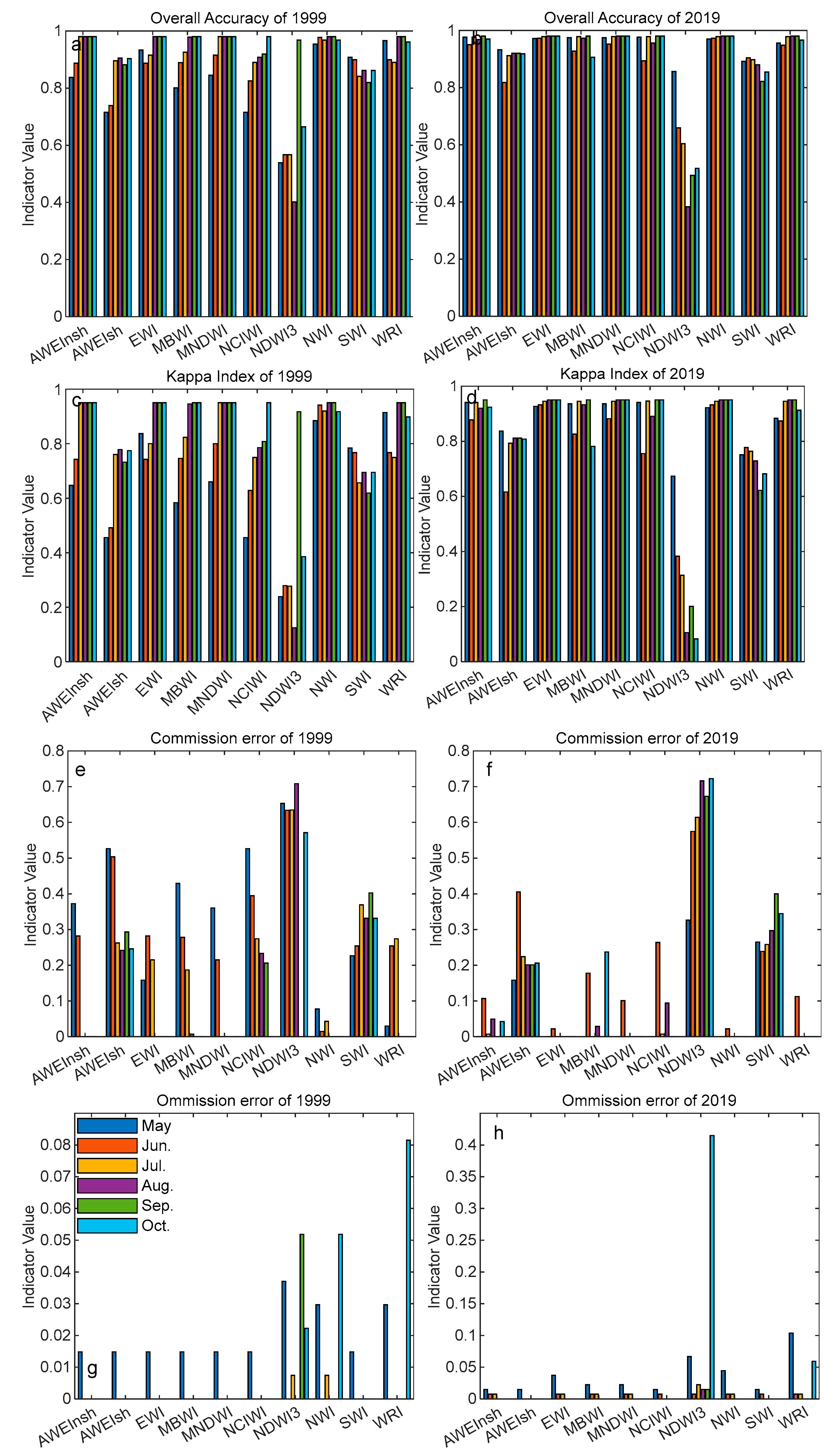
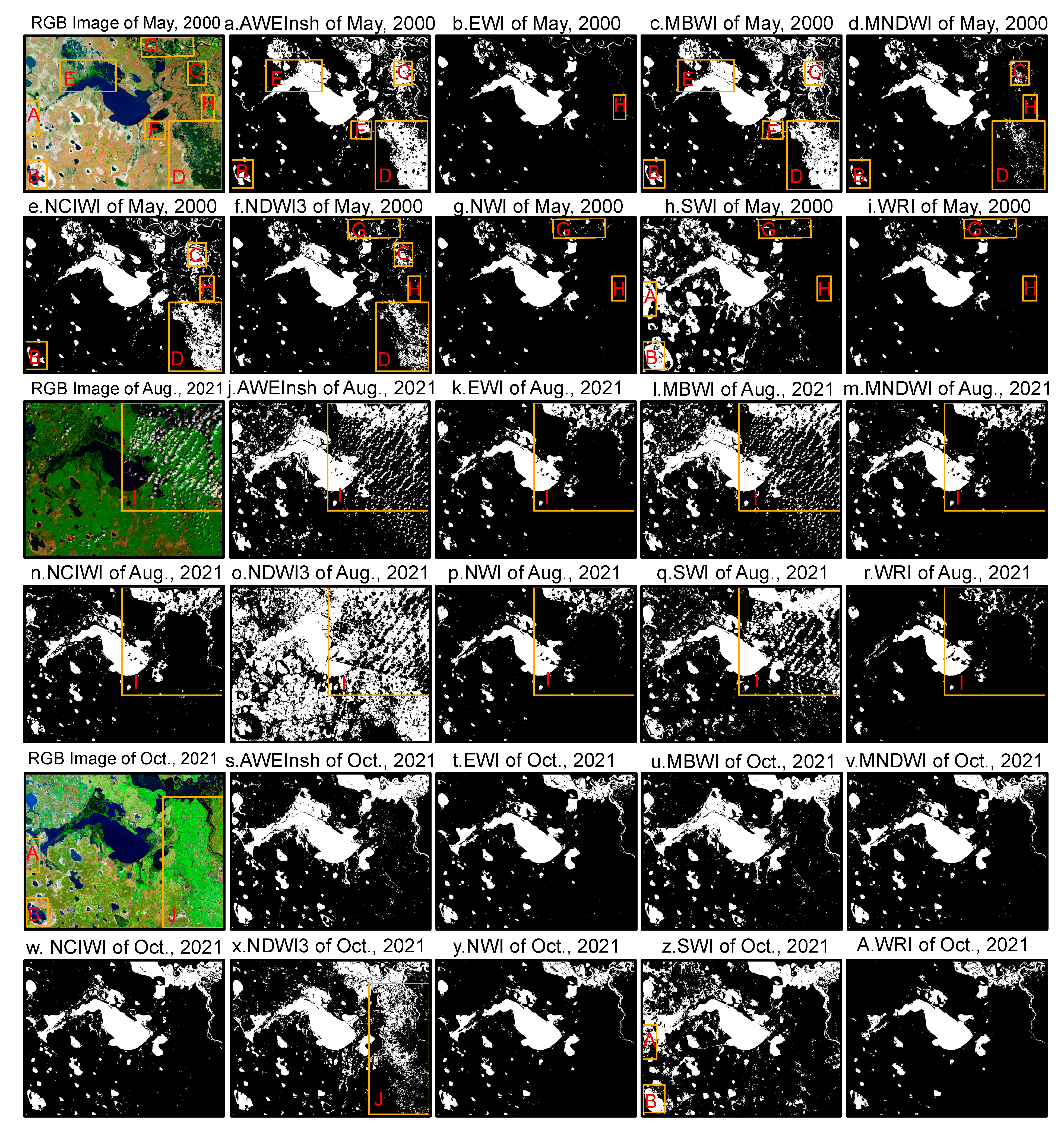
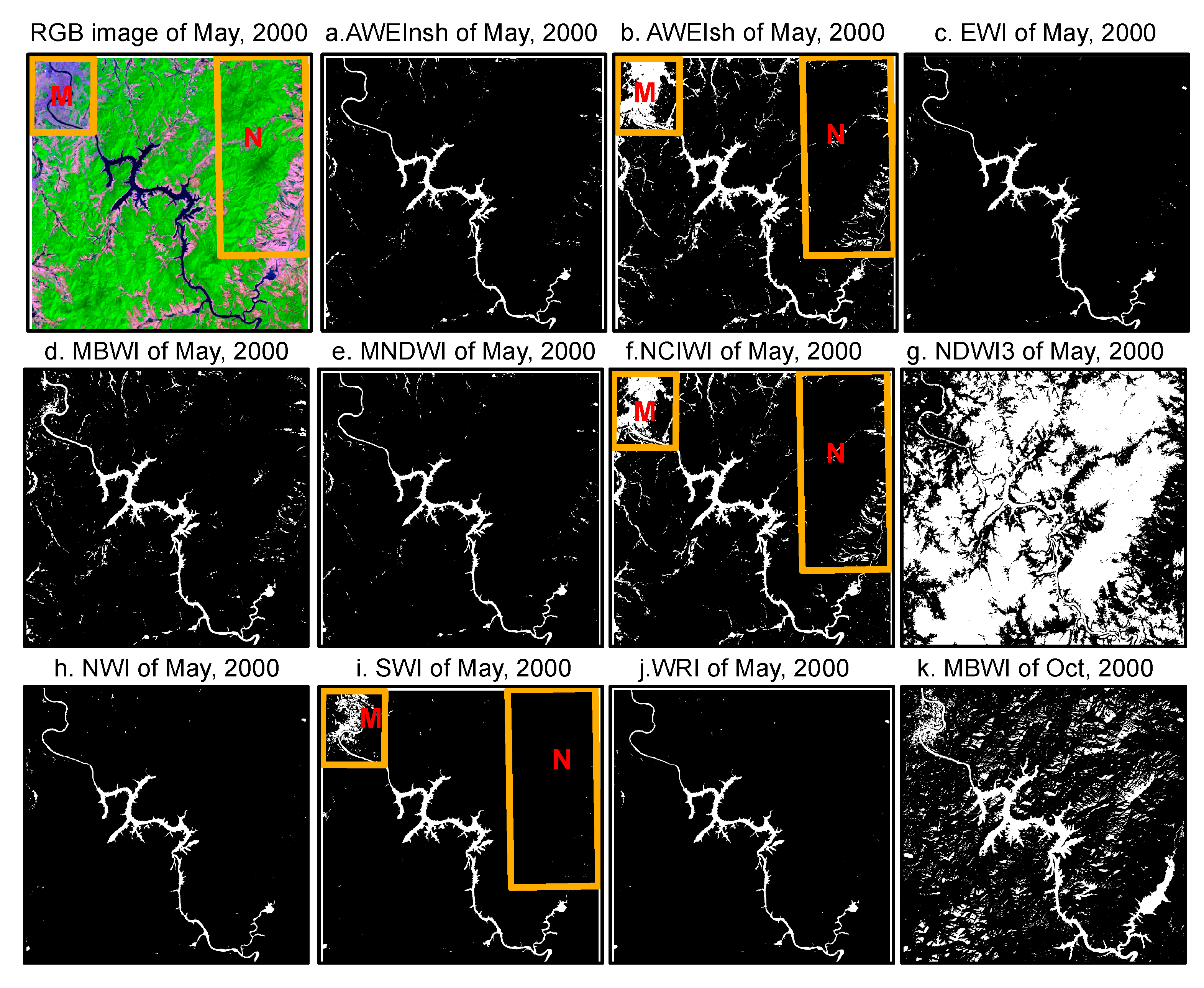
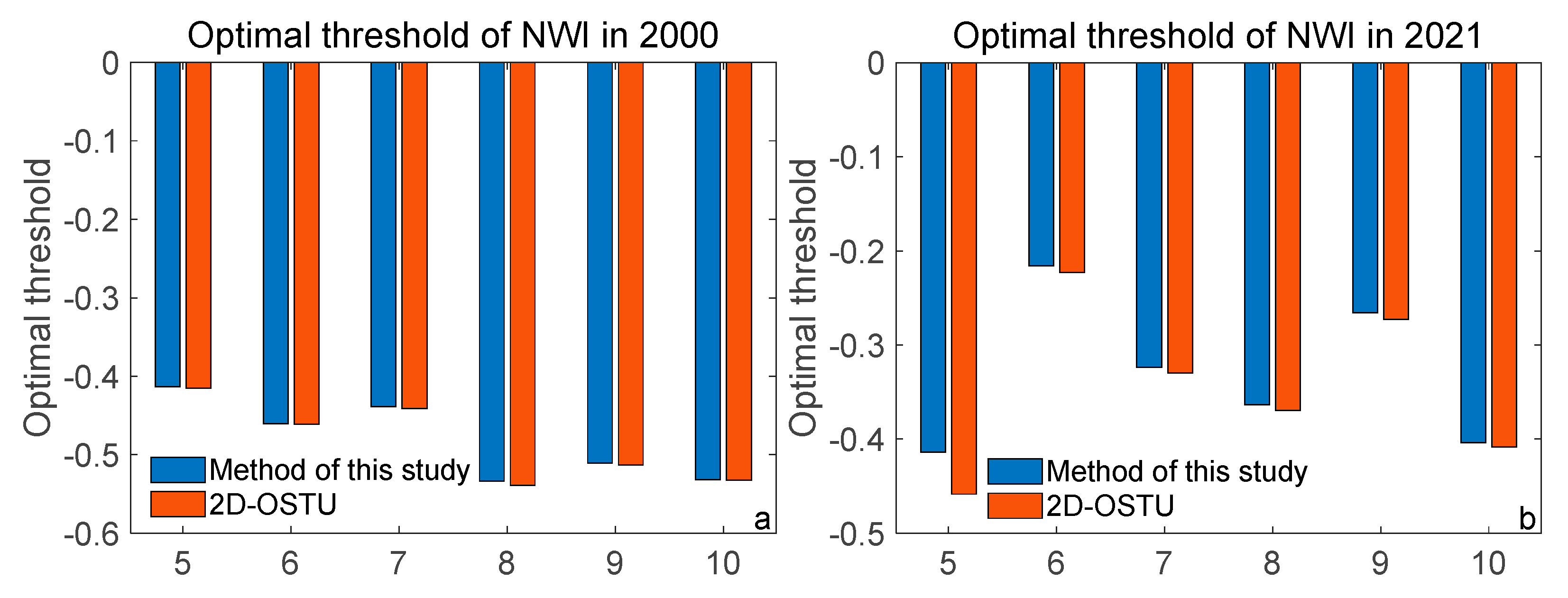

| No. | Band Name | Center Wavelength (nm) | Spatial Resolution (m) | |
|---|---|---|---|---|
| TM | OLI | |||
| 1 | Coastal Aerosol | - | 443 | 30 |
| 2 | Blue | 485 | 482 | 30 |
| 3 | Green | 569 | 561 | 30 |
| 4 | Red | 660 | 655 | 30 |
| 5 | NIR | 840 | 865 | 30 |
| 6 | SWIR1 | 1676 | 1609 | 30 |
| 7 | SWIR2 | 2223 | 2201 | 30 |
| 8 | Pan | - | 592 | 15 |
| 9 | Cirrus | - | 1373 | 30 |
| Path/Row | 119/028 (Chagan Lake) | 119/029 (Chagan Lake) | 117/030 (Songhua Lake) | |||
|---|---|---|---|---|---|---|
| Months | 2000 (TM) | 2021 (OLI) | 2000 (TM) | 2021 (OLI) | 1999 (TM) | 2019 (OLI) |
| May | 28 May 2000 | 22 May 2021 | 28 May 2000 | 22 May 2021 | 25 May 1998 | 3 May 2019 |
| June | 11 June 1999 | 7 June 2021 | 11 June 1999 | 7 June 2021 | 29 June 1999 | 1 June 2018 |
| July | 31 July 2000 | 22 July 2020 | 31 July 2000 | 22 July 2020 | 15 July 1999 | 6 July 2019 |
| August | 16 August 2000 | 26 August 2021 | 16 August 2000 | 17 August 2021 | 10 August 1997 | 31 August 2022 |
| 7 August 2020 | ||||||
| September | 15 September 1999 | 27 September 2021 | 15 September 1999 | 27 September 2021 | 3 September 2000 | 24 September 2019 |
| October | 3 October 2000 | 13 October 2021 | 3 October 2000 | 13 October 2021 | 3 October 1999 | 7 October 2018 |
| Land Use Type | Number of Samples | |
|---|---|---|
| Chagan Lake | Songhua Lake | |
| Water | 100 | 135 |
| Wetland | 45 | - |
| Paddy field | 100 | 80 |
| Dryland | 120 | 100 |
| Woods | 40 | 160 |
| Grassland | 50 | - |
| Construction land | 90 | 80 |
| Unused land | 30 | - |
| Index | Equation | Reference |
|---|---|---|
| AWEI | AWEInsh: 4 × (Green−SWIR1) − (0.25 × NIR + 2.75 × SWIR2) | [23] |
| AWEIsh: Blue + 2.5 × Green − 1.5 × (NIR + SWIR1) − 0.25 × SWIR2 | ||
| EWI | (Green − NIR − SWIR1)/(Green + NIR + SWIR1) | [17] |
| MBWI | 2 × Green−Red−NIR − SWIR1 − SWIR2 | [22] |
| MNDWI | (Green−SWIR1)/(Green + SWIR1) | [16] |
| NCIWI | (NIR − Red)/(NIR + Red) + NIR + SWIR1 + SWIR2 | [45] |
| NDWI3 | (NIR − SWIR1)/(NIR + SWIR1) | [46] |
| NWI | (Blue − NIR − SWIR1 − SWIR2)/(Blue + NIR + SWIR1 + SWIR2) | [18] |
| SWI | Blue + Green − NIR | [31] |
| WRI | (Green + Red)/(NIR + SWIR1) | [21] |
| IWS | 2 × (4 × SWIR1 − Blue)/SWIR1 − 2 × SWIR1/Blue 1 | [20] |
Disclaimer/Publisher’s Note: The statements, opinions and data contained in all publications are solely those of the individual author(s) and contributor(s) and not of MDPI and/or the editor(s). MDPI and/or the editor(s) disclaim responsibility for any injury to people or property resulting from any ideas, methods, instructions or products referred to in the content. |
© 2023 by the authors. Licensee MDPI, Basel, Switzerland. This article is an open access article distributed under the terms and conditions of the Creative Commons Attribution (CC BY) license (https://creativecommons.org/licenses/by/4.0/).
Share and Cite
Liu, S.; Wu, Y.; Zhang, G.; Lin, N.; Liu, Z. Comparing Water Indices for Landsat Data for Automated Surface Water Body Extraction under Complex Ground Background: A Case Study in Jilin Province. Remote Sens. 2023, 15, 1678. https://doi.org/10.3390/rs15061678
Liu S, Wu Y, Zhang G, Lin N, Liu Z. Comparing Water Indices for Landsat Data for Automated Surface Water Body Extraction under Complex Ground Background: A Case Study in Jilin Province. Remote Sensing. 2023; 15(6):1678. https://doi.org/10.3390/rs15061678
Chicago/Turabian StyleLiu, Shu, Yanfeng Wu, Guangxin Zhang, Nan Lin, and Zihao Liu. 2023. "Comparing Water Indices for Landsat Data for Automated Surface Water Body Extraction under Complex Ground Background: A Case Study in Jilin Province" Remote Sensing 15, no. 6: 1678. https://doi.org/10.3390/rs15061678
APA StyleLiu, S., Wu, Y., Zhang, G., Lin, N., & Liu, Z. (2023). Comparing Water Indices for Landsat Data for Automated Surface Water Body Extraction under Complex Ground Background: A Case Study in Jilin Province. Remote Sensing, 15(6), 1678. https://doi.org/10.3390/rs15061678







